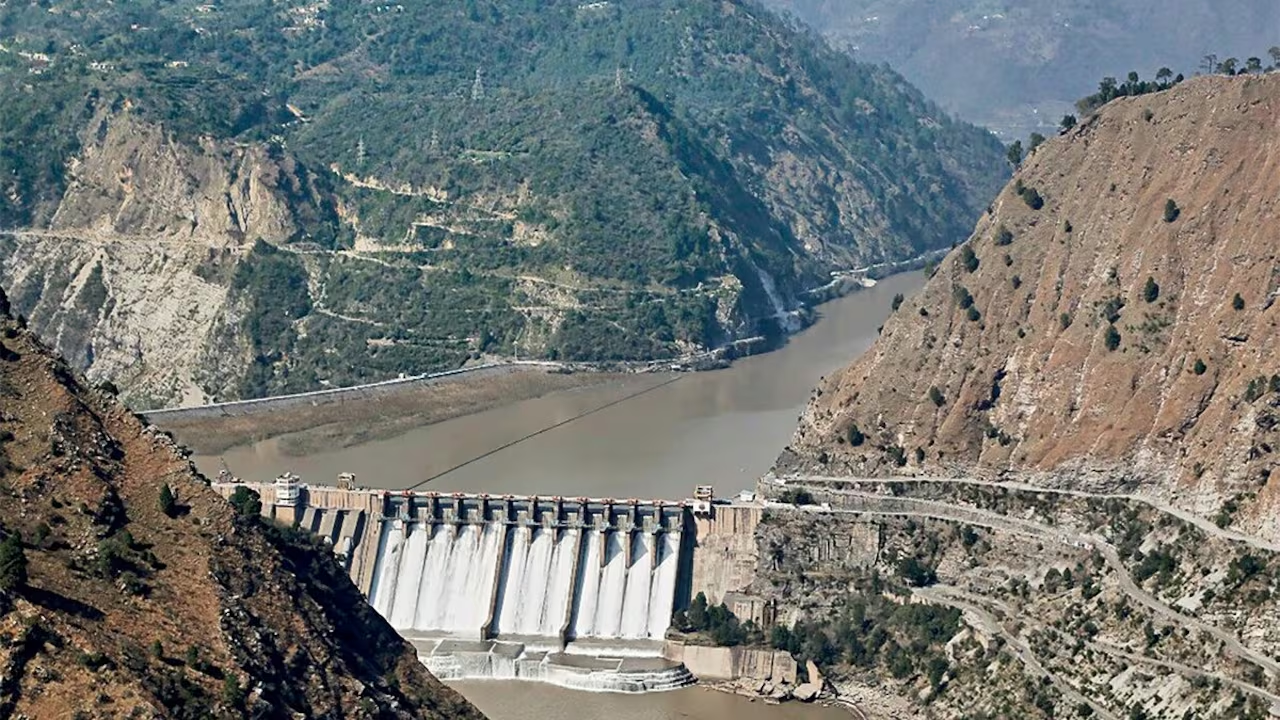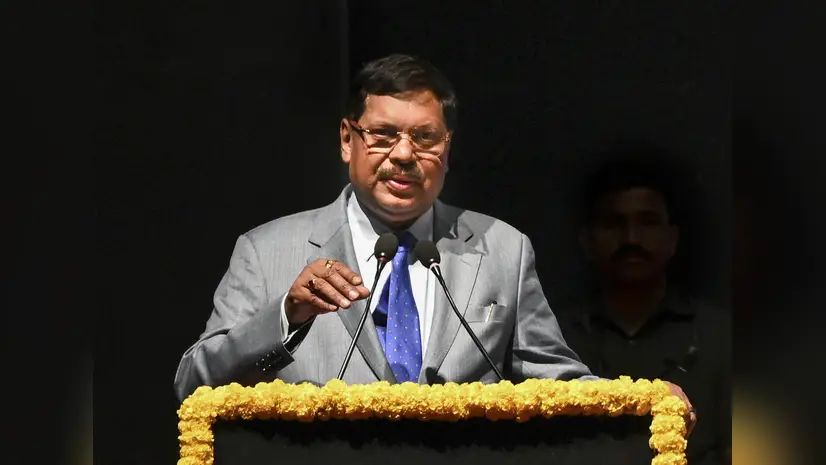- Courses
- GS Full Course 1 Year
- GS Full Course 2 Year
- GS Full Course 3 Year
- GS Full Course Till Selection
- Answer Alpha: Mains 2025 Mentorship
- MEP (Mains Enrichment Programme) Data, Facts
- Essay Target – 150+ Marks
- Online Program
- GS Recorded Course
- Polity
- Geography
- Economy
- Ancient, Medieval and Art & Culture AMAC
- Modern India, Post Independence & World History
- Environment
- Governance
- Science & Technology
- International Relations and Internal Security
- Disaster Management
- Ethics
- NCERT Current Affairs
- Indian Society and Social Issue
- NCERT- Science and Technology
- NCERT - Geography
- NCERT - Ancient History
- NCERT- World History
- NCERT Modern History
- CSAT
- 5 LAYERED ARJUNA Mentorship
- Public Administration Optional
- ABOUT US
- OUR TOPPERS
- TEST SERIES
- FREE STUDY MATERIAL
- VIDEOS
- CONTACT US
ASER 2024: A glimpse of status of rural school education
ASER 2024: A glimpse of status of rural school education
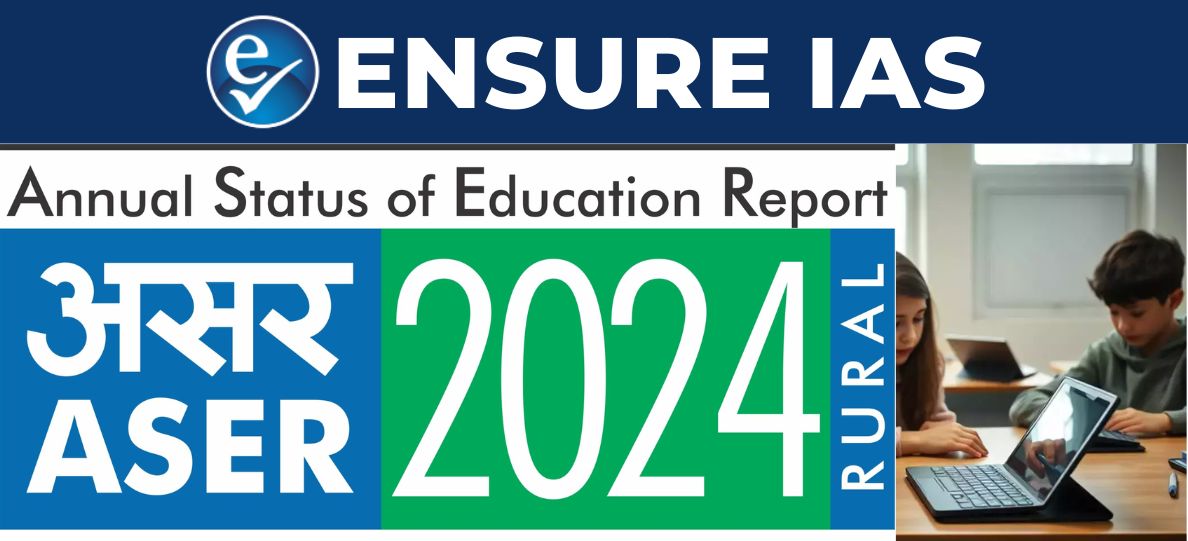
Recent context
- Recently, the Annual Status of Education Report (ASER) 2024 that captures the status of children’s enrollment and learning outcomes in rural India was released.
- The 2024 ASER survey reached 6,49,491 children in 17,997 villages across 605 rural districts. ASER 2024 is the 14th nationwide field-based ASER survey.
- The findings of this report are crucial because it is only the second such report after the Covid-19 pandemic, the last one being 2022. As per the report, school education has either recovered from the pandemic’s losses or is on its way to doing so.
What is the Annual Status of Education Report?
What are the key features of the methodology of ASER?
|
Key findings of the report
-
Improvement in learning outcomes
- The share of children (the report gives data for students in standard III, V, and VIII) who could read a standard II level text or subtract, and divide had fallen between 2018 and 2022. But this share was either back to 2018 levels or shows improvement compared to 2022 levels across the board.
- This shows that there has been recovery from the “learning loss” seen after the pandemic.
- Learning loss refers to the decline in students' academic knowledge and skills due to disruptions in education, such as the COVID-19 pandemic.
- Improvement in arithmetic levels:
- The percentage of Std III children who can perform at least subtraction at the basic arithmetic level was 33.7% in 2024, up from 25.9% in 2022 and higher than the pre-pandemic rate of 28.2% in 2018.
- The percentage of children enrolled in Std V who can solve a 3-digit by 1-digit division problem increased from 25.6% in 2022 to 30.7% in 2024.
- Improvement in reading:
- The percentage of children enrolled in Std III who can at least read a Std II level text increased from 20.5% in 2022 to 27% in 2024.
- The percentage of children enrolled in Std V who can at least read a Std II level text increased from 42.8% in 2022 to 48.8% in 2024.
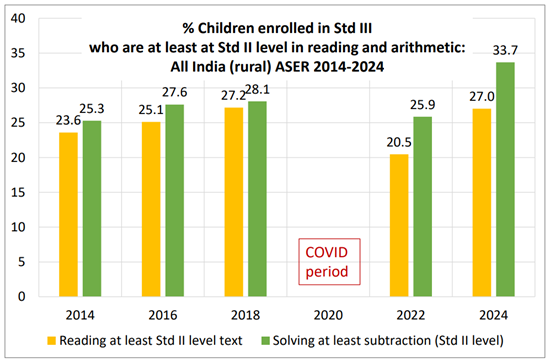
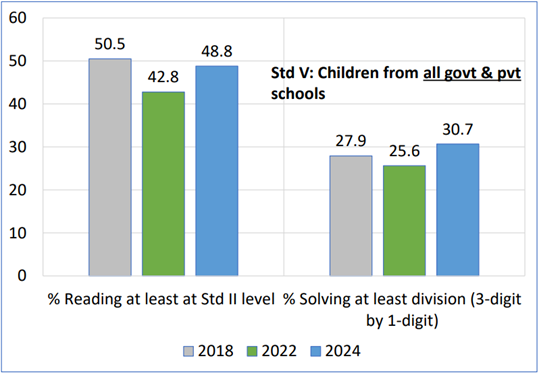
e. The improvements were faster in government schools than private schools, although the former still lagged the latter in absolute terms.
- For instance, in government schools, the percentage of Class 5 children who can now read a text at the Class 2 level was 44.8% in 2024, up from 38.5% in 2022 and nearly matching the 2018 rate of 44.2%. schools.
- However, this percentage has not yet reached pre-pandemic levels at private schools; in 2024, it was 59.3%, up from 56.8% in 2022, but still less than 65.1% in 2018.
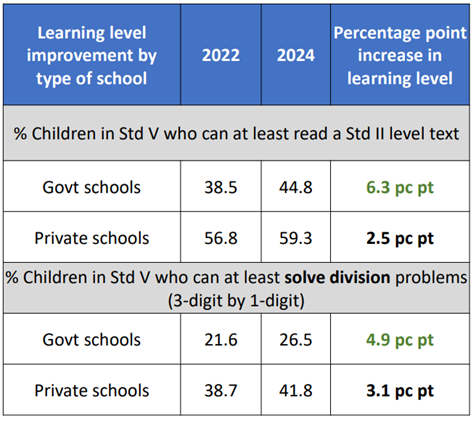
2. Enrollment
a. Age 3-5: Enrollment in early childhood education programs or preschool is high – close to 80% for age 3 and 4.
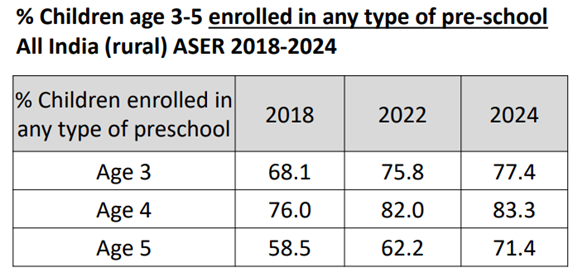
b. Age 6-14: Overall enrollment in school for age group 6-14 remains very high at 98%.
c. Age 14-16: Out of school numbers for age 15-16 is now 8% or less for boys and girls. Gender gap is less than 1%.
d. In pre-primary schools for children aged five, Karnataka, Gujarat, Maharashtra, Kerala, and Nagaland are among the states with enrollment rates above 90%.
e. Private schools: The report shows a rise in private school enrolment levels compared to 2022 and a fall in the share of students in government schools. It has increased from 25.1% of enrolled children (age 6-14) in 2022 to 30.6% in 2024. This seems to be because of the rise in income levels in rural areas after the pandemic.
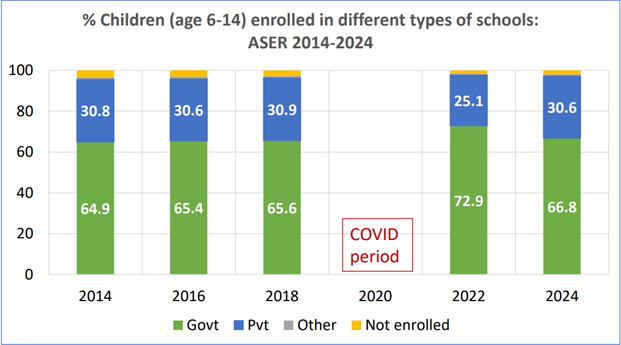
3. Attendance
- The data in the report shows that both teacher and student attendance in government elementary schools have increased.
- Student attendance: Increased from 72.4% in 2018 to 73% in 2022 to 75.9% in 2024.
- Teacher attendance: Increased from 85.1% in 2018, to 86.8% in 2022 and 87.5% in 2024.
4. Digital access and skills
- This was also the first full-length ASER survey to record digital literacy among older children (14 to 16 years).
- Digital access: More than 90% of rural adolescents have access to a smartphone.
- Digital skills: About 82.2% of the children said they knew how to use one
- Gender gaps: It exists in terms of both accessibility and skills. For instance, there is a gender gap in smartphone ownership, with 36.2 per cent of boys and 26.9 per cent of girls reporting owning one. Also, 80.1% of boys (ages 14 to 16) could browse for information, against 78.6% of girls.
- Usage: 57% of teenagers use a smart device for education-related activities, although about 76% use it for social media.
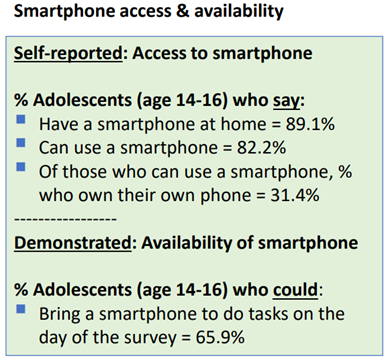
5. Consistent improvement in school facilities
- There has been a consistent increase in school services and facilities like midday meals, drinking water, usable toilets, libraries etc.
- For instance, the percentage of schools with usable toilets increased from 74.2% in 2018 to 79% in 2024
- The percentage of schools with no library decreased from 25.8% in 2018 to 17.5% in 2024
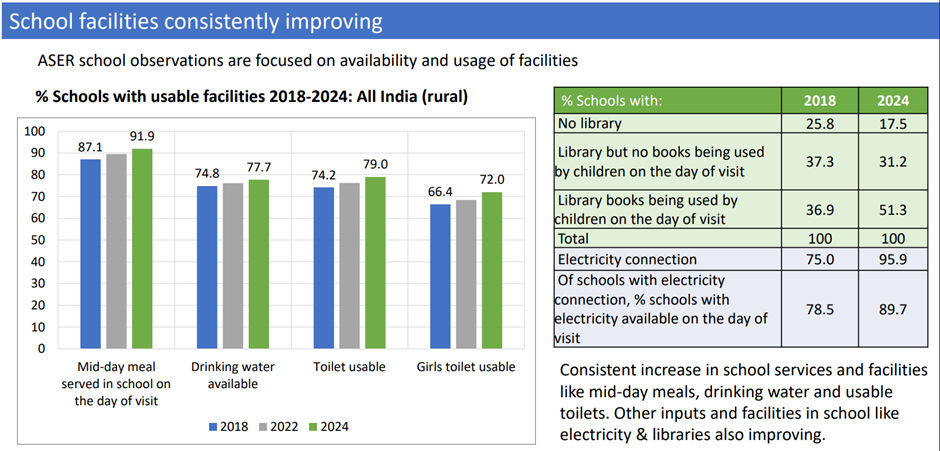
What impact does the National Educational Policy 2020 have on the positive learning outcomes as seen in ASER 2024?
- Since the launch of the National Education Policy in 2020, high priority has been placed on helping children in early grades in primary school acquire foundational literacy and numeracy (FLN) skills.
- The National Initiative for Proficiency in Reading with Understanding and Numeracy (NIPUN) Bharat was launched in 2021 for improving these skills. It aims to achieve Foundational Literacy and Numeracy by 2026-27, where, by Grade 3 (age 8) every child can:
- Read with comprehension
- Write
- Perform basic mathematical operations
- Learn basic life skills
- The National Initiative for Proficiency in Reading with Understanding and Numeracy (NIPUN) Bharat was launched in 2021 for improving these skills. It aims to achieve Foundational Literacy and Numeracy by 2026-27, where, by Grade 3 (age 8) every child can:
- The ASER survey found that at the all-India level, 83% of schools said they received directives from the government to implement FLN activities. Around 78% said that at least one teacher in the school had been trained on FLN, while 75% also received relevant learning material.
- Three month “school readiness” programs for incoming Std I children are also being conducted in government primary schools.
- Due to these efforts under the NEP 2020, there have been improvements in the learning outcomes of children.
What is the National Education policy, 2020?
|
Must Read: UDISE+ 2023-24 Report Reveals Sharp Decline in School Enrolment
What are the challenges that persist as per ASER 2024?
- Learning gaps are still present: Despite the improvements, in absolute terms the learning outcomes are poor. For instance, 76.6% of Class III government school students and 55.2% of Class V government schools students are still unable to read Class II text.
- Disparities between states: For instance, in standard III, reading ability in more than half the states was behind 2018 levels in 2024.
- Gender Gaps: For instance, there is a gender gap in smartphone ownership, with 36.2 per cent of boys and 26.9 per cent of girls reporting owning one. Also, 80.1% of boys (ages 14 to 16) could browse for information, against 78.6% of girls.
- Infrastructure gaps: Despite progress, school infrastructure in rural areas remains inadequate. For instance, as of 2024 only 77% of the schools had drinking water facilities and only 79% of schools had usable toilets.
Way forward
- Addressing Poor Learning Outcomes: Implement remedial programs like Teaching at the Right Level (TaRL) and activity-based learning in classrooms.
- Strengthening Foundational Literacy & Numeracy (FLN): Effective implementation of NIPUN Bharat (FLN Mission), more focus on interactive learning, phonics-based reading etc.
- Improving Teacher Training: This can include training to use technology-based tools for teaching.
- Bridging the Digital Divide: This can be done through affordable devices & internet connectivity in rural areas, inclusion of digital literacy as part of the curriculum etc.
- Improving School Infrastructure & Resources: Through 100% electrification of schools, construction of toilets, libraries etc.
Conclusion
The ASER 2024 report thus highlights both the progress and persistent challenges in India's rural education system. To address these challenges, policymakers, educators, and communities must work together to ensure that every child not only attends school but also receives quality education. The improvement in learning outcomes, digital access and school infrastructure are crucial in shaping India's future learning landscape.
|
Also Read |
|
UPSC Foundation Course |
UPSC Daily Current Affairs |
UPSC Monthly Mgazine |
CSAT Foundation Course |
Free MCQs for UPSC Prelims |
UPSC Test Series |
ENSURE IAS NOTES |
Our Booklist |


